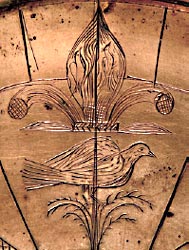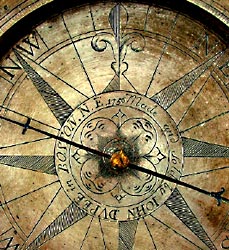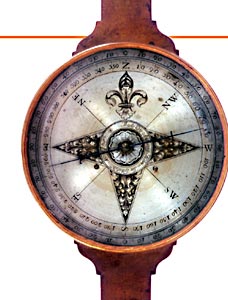The Art of Brass Colonial Surveying Instruments
 Lewis Michael brass compass
Lewis Michael brass compassCopyright Jeffrey Lock, Colonial Instruments
When I first laid my eyes on the brass Lewis Michael compass, words could not describe the emotions I felt. I was looking at one of the most beautifully engraved examples of the 18th century Colonial instrument maker's art. I have been collecting Colonial antiques for decades and had never seen an example of craftsmanship that touched me on a personal level as did this instrument. Little did I know that I was embarking on a wondrous journey that would include volumes of historical information and admiration of extraordinary craftsmanship that is seldom enjoyed by students of 18th century Colonial Americana.
Those of us that savor the beauty and historical significance of Colonial antiques find unique qualities displayed in the design and craftsmanship. It is easy to find information on various disciplines such as clockmakers, silversmiths, and cabinetmakers. One area that is very seldom studied, because examples are quite rare, is that of the colonial instrument maker. When I speak of instrument maker, I am talking primarily of the maker of surveying instruments, instruments that were necessary to record the vast amounts of seemingly limitless tracts of land that made up the early colonies. This newly discovered continent was made up of forests for as far as the eye could see which had to be divided and prepared for sale to the newly arriving colonists. The surveyors would measure and mark boundary lines for farms, villages, towns, and roads. To those unfamiliar with this particular occupation, it sounds like a purely mathematical and historical discussion. But there is an astonishing beauty in the instruments of surveying, especially when we are looking at those of the 18th century.
 Detail of fleur-de-lis from brass compass, David Main, dated 1800
Detail of fleur-de-lis from brass compass, David Main, dated 1800Copyright Jeffrey Lock,Colonial Instruments
Instruments for this purpose were initially imported from England and, a lesser amount from the European continent. It took several decades before instruments were being constructed in the colonies for use by the local surveyors. In the first quarter of the 18th century, a small group of craftsmen began producing surveying instruments in the colonies. By the mid 18th century more instrument makers became proficient and began supplying instruments for the ever increasing demand. The majority of these early instrument makers received their ideas from the English instruments. The style of engraving the brass surface with the decorative points of the compass was heavily influenced by the instruments brought over from England. This influence was not dogmatic, it was merely inspirational. The colonial instrument makers had a desire to produce their own particular style that was not a direct copy of English instruments. The styles of numbering, engraving, and the decoration became quite particular to a given maker and, as a group, individualistic to the colonies.
 Portion of engraved face of brass compass by John Dupee, Boston, dated 1756
Portion of engraved face of brass compass by John Dupee, Boston, dated 1756Copyright Jeffrey Lock, Colonial Instruments
As a general rule, English instruments were produced by professional instrument makers who had access to professional engravers as well as very accurate methods of dividing the needle ring. Pictured is an example of a late 17th century instrument constructed around 1665 by an English maker for one of the original proprietors of the Carolinas, Sir Thomas Colleton. This instrument is a large theodolite, extremely well made, and in remarkable original condition. The extraordinary circumstance regarding this instrument is that it still retains the original octagonal, walnut case that was built specifically for this theodolite. Very few instruments brought into the colonies at such an early date still remain. This may be one of the only instruments that can be directly associated with a first generation proprietor from the 17th century.
However, early brass instruments are quite rare prior to 1750. As the colonial makers began constructing instruments for the local surveyors, the majority of them were made out of wood indigenous to New England. Despite the added cost, brass quickly became the material of choice due to its ability to hold up to the rigors of the surveying environment. Wood was much more easily damaged the sight vanes, for example, could be broken or the wood of the compass body could warp and crack.
Brass in the colonies was a controlled commodity and many of the makers advertised for used brass from kettles and flatware to melt down, providing the raw materials for production of their instruments. Therefore sockets, sight vanes, and items of this nature were made on quite a small scale which was sufficiently strong to produce the desired rigidity but not of the massiveness of the English instruments from the same period where brass was much more available.
In direct contrast to the professional English maker, the majority of the instruments crafted in the colonies were made and engraved by the instrument maker. It is very easy to distinguish instruments by the same maker exhibiting a consistent, individualistic engraving style that was common to the instruments fabricated during that maker's entire career. Maturation of metalworking and engraving style can be seen as one studies all the examples of a particular maker as the number of mistakes made in the engraving lessens as the instrument maker becomes more proficient in his craft.
 Close up engraving detail from mid-18th century semi-circumferentor by Nathan Deane
Close up engraving detail from mid-18th century semi-circumferentor by Nathan DeaneCopyright Jeffrey Lock, Colonial Instruments
Upon studying these instruments, the common, endearing characteristic from these makers was their naïve engraving style and the conservative manner in which brass was utilized. Many of these makers were obviously not professional engravers and literally taught themselves to engrave. Brass as a material is more difficult to engrave than copper, which was more commonly used in book printing and map plates. Copper is a softer material that lends itself more readily to engraving with a burin; brass is a somewhat harder material and the casting processes in these early days did not necessarily produce a brass of totally uniform hardness.
One finds that when you are learning to engrave it is very easy to draw out a design, but when you attempt to engrave that same design in brass, the ease by which it was drawn is no longer the case when it comes to engraving the pattern in brass. But it is this naiveté in engraving style that makes these instruments from the 18th century such valuable historical pieces. It shows a provinciality that one will find in the English countryside instruments, which would be seldom, if ever, found in the compasses made in the cosmopolitan areas such as London. Brass instruments, however, by makers such as Greenough and Dupee of Boston, show a level of engraving sophistication that is less exact but more endearing because of it inexactitude. It is these endearing qualities of these instruments that provide the focal point for the study of these makers and their early attempts at producing instruments that the Colonial surveyors were interested in purchasing.
 Brass surveying compass by Anthony Ham, Philadelphia, circa 1750
Brass surveying compass by Anthony Ham, Philadelphia, circa 1750Copyright Jeffrey Lock, Colonial Instruments
Once the machine age took over in the 1820's and later, the instrument engraving quality was reduced to merely a token decorative aspect that suffered greatly in comparison to the early instruments where the engraving was considered to be an integral part of the design of the instrument. The craftsman of this early period found it necessary to express himself in an artistic manner. The majority of the professionally made instruments in the colonies exhibited a high level of engraving incorporating the signature, and sometimes the date and location of the instrument maker.
The Lewis Michael compass that caught my eye originally, I found out much later, was made by one of the foremost instrument makers of the Colonial period. Lewis Michael apprenticed with Benjamin Rittenhouse, another leading instrument and clockmaker, and practiced his crafts of silversmith, watchmaker, clockmaker, and instrument maker in York and Somerset counties of Pennsylvania.
His instruments are extremely desirable and very hard to find on the open market. I stumbled across this exquisite compass at a local antique show and made an emotional decision to purchase it knowing absolutely nothing about the field in general and Lewis Michael in particular. As we all know, our instincts often provide the most reliable information.
Resources:
Also in this Issue:
- The Art of Brass Colonial Surveying Instruments
- P.E. Guerin Foundry Continues their Legacy of Artistic Metalwork
- Capturing the Beauty of the Body in Bronze: Artist Richard MacDonald
- Nature's Creations: Creating One-of-a-Kind Copper Keepsakes
- Art Foundry Gallery Hosts 2008 Beijing Olympic Sculpture Exhibition
